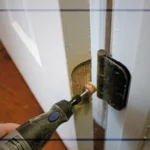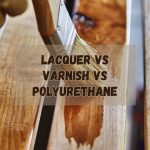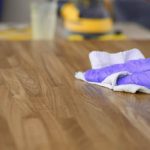How To Fix Scratches On Wood Floors – A Step-By-Step Guide
Wood floors can get scratched in several ways, such as dragging heavy furniture or dropping a sharp knife. Luckily, most scratches are easy to fix.
Wondering how to fix scratches on wood floors? Start by determining what kind of scratch they are and then fix them as follows;
- Superficial scratches – Use coconut oil, walnut, or a mix of olive oil and vinegar.
- Minor scratches – Apply floor wax, finish restorers, or use blending pencils.
- Dents – Use wood fillers or putty.
Keep reading to learn more about how wood floors get scratched, how to prevent this scratching, and how to identify and fix any scratches that occur.
How To Assess Wood Floor Scratches?
It’s important to assess the level of damage sustained by your wood floor before you embark on fixing it. Here’s a guide to help you assess your wood floor;
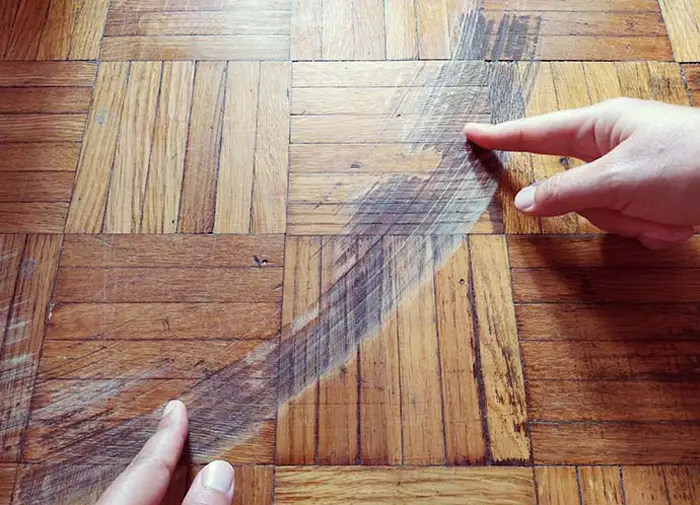
- Ensure you have proper lighting. You can use a bright lamp or assess the floor during the day.
- Clean the floor to eliminate any dirt or debris that may prevent you from observing scratches. You can use a soft broom or a vacuum to sweep.
- Observe the scratches closely to determine their depth.
- Check the wood for color changes because deep wounds often expose bare wood, which can be darker or lighter than the finished surface.
- To understand their average size, compare the length and width of any scratches you find.
- Observe the scratch pattern to determine what caused them so that you can prevent it in the future. Check the direction of the scratches and determine whether they run with the grain or across it.
- Feel the wood surface for any raised wood fibers.
- Look for dents or gouges in the wood.
- Inspect the condition of the finish around the scratches to determine whether it needs to be redone.
Generally, there are three levels of scratch damage that a floor can have;
- Superficial
- Minor
- Major
How To Fix Scratches On Wood Floors?
There are several ways to fix a scratched wood floor, depending on the level of damage. Here are some of the steps you can take to fix a wood floor according to scratch type;

1. Superficial scratches
Superficial scratches are the easiest to deal with because they only affect the wood finish. To fix a superficial scratch, follow the steps below.
- Clean the area around the scratch using a microfiber rag.
- Use the microfiber rag to buff the scratch along the direction of the grain. Buffing will smoothen the coating and restore its shine.
- If the scratch is still visible after buffing, try the following;
- Apply a thin layer of wax by rubbing a wax stick on it and smooth it to get a polished look.
- Another solution is to apply a one-to-one mixture of olive oil and vinegar. Wipe it after a few hours to fix the scratch.
- You can apply coconut oil using a lint-free cloth, allow it to penetrate for some time, and then rub it off.
- Since walnuts are rich in oils, rubbing one on the scratch and wiping it after half an hour will produce a clean, polished look.
2. Minor scratches
Minor scratches get past the protective wood finish and damage the wood. Here’s how to deal with this type of scratch;
Clean the area around the scratch with a cotton cloth or microfiber rag to eliminate dirt or debris. Wipe it dry with another cotton cloth.
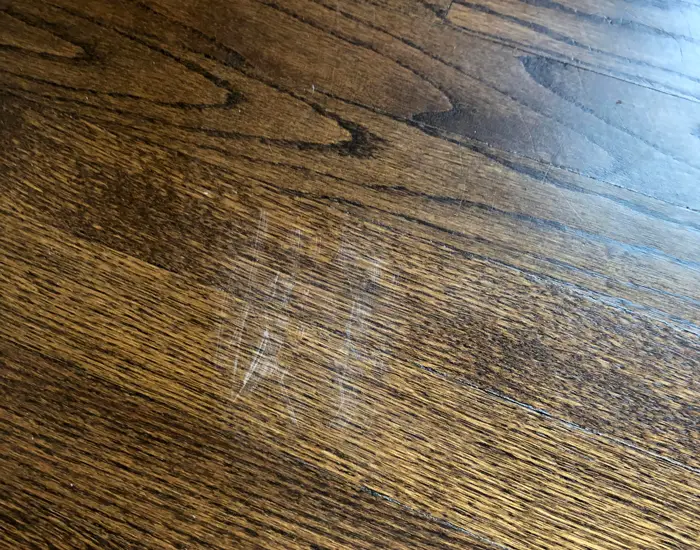
Once the wood is clean and dry, try the following fixes;
- Using Blending Pencil: Use blending pencils to fill in the scratches. When using these pencils, select a color that perfectly blends in with your wood floor color.
- Using Wood Stain: Dab a small amount of wood stain over the scratch and rub it off with a cotton cloth. Always use a wood stain that matches your floor’s color.
- Using Finish Restorer: If you have several scratches, use a soft cloth to apply the finish restorer over the affected area and gently rub it in. Allow the restorer to sit before wiping with a clean, soft cloth for a shiny, polished appearance.
- Using Floor Wax: Floor wax is another great way to eliminate scratches because it fills them up. Apply it with a soft, dry cloth and wipe off the excess for a polished look.
Here’s an illustrative video on how to fix scratches on a wood floor.
3. Major scratches
Major scratches include deep scratches, gouges, and dents. Here’s how to fix deep scratches and dents;
- Step 1: Clean the area using a microfiber cloth and wipe it dry.
- Step 2: Once the surface is clean, use wood filler or putty to fill the scratches and dents. In this step, you can use a putty knife to spread the wood filler or putty into the scratch and make it level with the surrounding wood surface.
- Step 3: Wait for the wood filler to dry completely, then use fine sandpaper to smoothen its surface to blend with the surrounding wood. Always sand in the direction of the wood grain for the best results.
- Step 4: If the area covered by the wood filler or putty looks different from the rest of the floor, apply an appropriate wood stain or finish to blend the color.
How Do Wood Floors Get Scratched?
Understanding the reasons that cause scratches to your wood floor is important for future prevention of scratches. Some common ways that wood floors get scratched include the following;
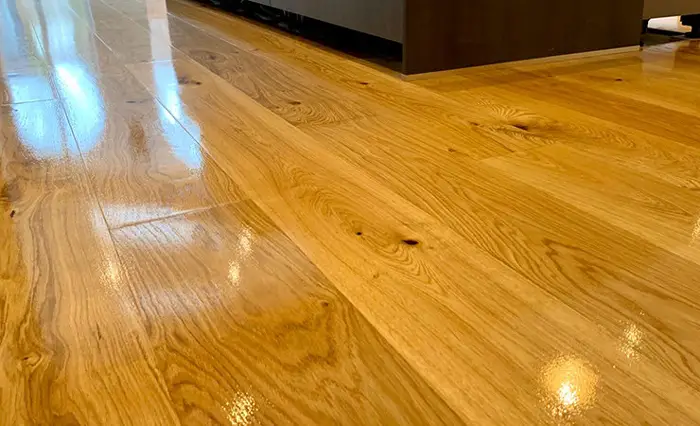
- Furniture: Moving or dragging heavy furniture across a wood floor without protective pads often leads to deep scratching and gouging.
- Pets: Pets with sharp claws, like dogs and cats, can damage your floor when they play and run vigorously, using the wood floor to slow down.
- Shoes: Some types of shoes, like heels and cleats, concentrate a lot of pressure on a small area, causing dents on the floor. Furthermore, if you slip while wearing heels or cleats, you’re likely to cause a deep scratch.
- Accidental drops: Dropping heavy objects like metal balls or rods can cause deep dents on your wooden floor. Similarly, dropping knives, axes, machetes, and other sharp tools will result in deep scratches or punctures on your floor.
- Sand: Fine particles like sand and dirt can cause scratches on wood floors when you walk over them or even during cleaning.
- Water: Water spills or prolonged exposure to high amounts of moisture can cause the wood to swell and warp unevenly, eventually causing scratches on the surface.
- Improper cleaning: Harsh chemicals and abrasive cleaning tools can damage a wood floor’s surface and cause extensive scratching.
How To Prevent Scratches On Wood Floors?
To prevent scratches and keep your wood floor looking mint, consider implementing the following measures;
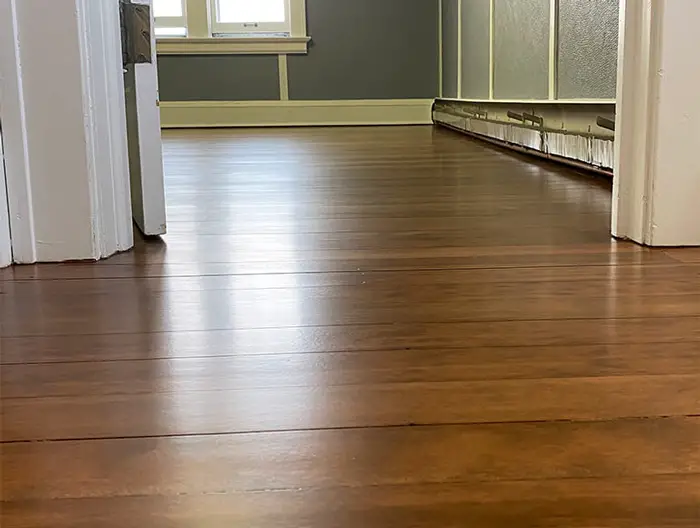
- Use rugs: Place rugs and mats near all doors and entryways to capture the sand shoes carry before they reach the wood floor.
- Cut your pet’s nails: If you have a playful or highly active pet, trim its toes regularly to avoid scratches.
- Use protective pads: Attach protective pads to the bottom of all your furniture legs to protect the floor whenever you move your furniture.
- Lift the furniture: Try lifting heavy furniture whenever you move it across the floor to eliminate the chances of scratching it.
- Remove shoes: Take off your high heels and cleats before walking on your wood floor. You should also remove the regular shoes to avoid spreading dirt and sand on the floor.
- Handle sharp or heavy objects carefully: Take extra precautions to avoid dropping sharp objects like knives and axes or heavy objects like metal rods on your wood floor.
- Cleaning: Use the appropriate cleaning tools and chemicals for your floor to avoid damage. Regularly sweep the floor and clean any water spills immediately to prevent the wood from swelling and warping.
- Control indoor humidity: Carefully regulate the humidity in your house to prevent your wood floors from swelling or warping, which can cause scratching.
FAQs
Here are some answers to common questions about fixing scratches on wood floors.
Q: Can black tea fix scratches on wood floors?
Black tea cannot fix wood scratches. However, black tea contains certain chemicals called tannins that can darken a wood’s surface, thereby concealing any superficial scratches that may be present.
Q: Can coffee grounds fix scratches on wood floors?
Coffee grounds are a poor choice for fixing scratches on wood floors. Though they may darken the wood surface a little, they’re extremely ineffective since you will still be able to see the scratches.
Q: What do I do if my wood floor is full of scratches?
If your wood floor is chock-full of scratches, the best solution is to refinish it. Clean the floor, sand it to completely remove the previous stain, and apply any finish you like.
Conclusion
Generally, you can use coconut oil, walnut, or a mix of olive oil and vinegar to fix superficial scratches. For minor scratches, the best solutions are blending pencils, floor wax, or finish restorers. As for major scratches and dents, the only way to fix them properly is by applying wood filler or putty.
The most common causes of wood floor scratching include playful pets with long claws, dragging heavy furniture, and dropping sharp objects like knives. To avoid scratching your floor, place protective pads beneath your furniture’s legs, put rugs on your doorways, and trim your pets’ nails.


